Sports
Lia Thomas is NCAA’s first Transgender D-1 National Champion
Despite the change in trans participation policies by USA Swimming that would have disqualified her, NCAA ruled Thomas was qualified to swim

Lia Thomas, a senior at the University of Pennsylvania, swam faster than any other woman in the 500-yard freestyle competition Thursday in Atlanta and made history by doing so. Not just because she finished in 4:33:24, more than a second faster than her closest competitor, but because she is an out transgender woman.
Her honor came at the Women’s Swimming and Diving National Championships, and despite rules that require her to speak to the news media following her win, Thomas spoke only to ESPN and “declined” attending the mandatory news conference, according to a spokesperson.
As for her victory, there are people who are plenty mad about it. When ESPN interviewed the 22-year-old, live, following the event, and some in the crowd booed.
“I didn’t have a whole lot of expectations for this meet,” Thomas told ESPN, according to a transcript of the interview provided by out nonbinary journalist Katie Barnes. “I was just happy to be here, trying to race and compete as best as I could.”
The ESPN correspondent asked the Austin, Texas native about competing “under the spotlight.”
“I try to ignore it as much as I can. I try to focus on my swimming, what I need to do to get ready for my races and just try to block out everything else,” Thomas said. She added: ”It means the world to be here, being with two of my best friends and teammates and to be able to compete.”
The interview ended, and some in the stands booed. Among the parents and supporters from across the country were demonstrators from an anti-transgender inclusion organization, Save Women’s Sports.
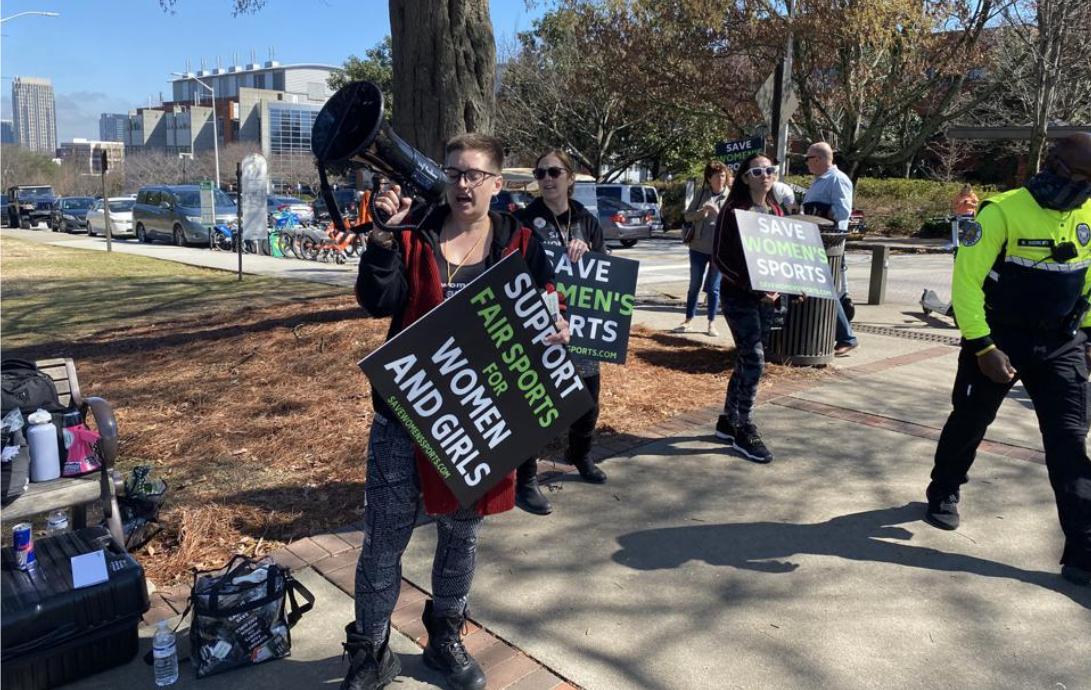
“It’s not right. It’s not fair,” Beth Stelzer, the group’s founder, told me amid a crowd of about 20 anti-trans protesters, waving signs and leading chants with a bullhorn outside the McAuley Aquatics Center on the campus of Georgia Tech.
“We are here to give these girls, parents, coaches, that are too afraid to speak up a voice, because women matter. We won’t say no. Save women’s sports!”
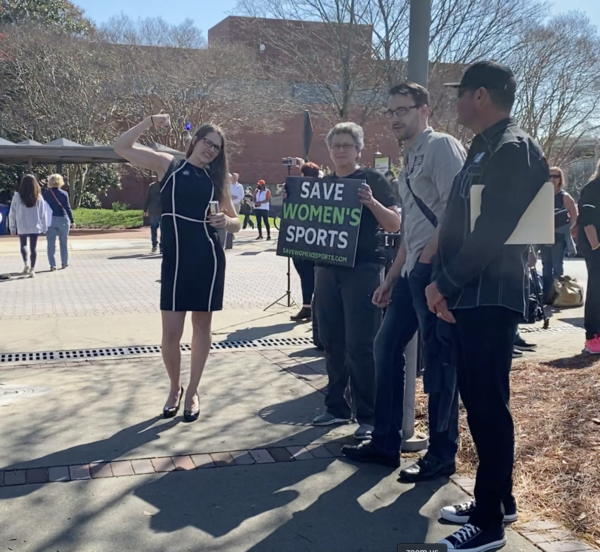
Despite the change in transgender participation policies by USA Swimming that would have disqualified her, the NCAA ruled earlier this month that Thomas was qualified to swim. I asked Stelzer, who is an amateur powerlifter, about the fact that Thomas is competing fair and square, according to the NCAA.
“I think it’s cowardly,” said Stelzer. “I think that it has been driven by money and feelings, instead of doing what is right and what is right is protecting women.”
According to one of the university officials keeping a close eye on the competing demonstrations, there were no altercations, no arrests, no injuries, and, he told me, he saw “no women in need of protecting.” He declined to give his name.
Another official told me he needed to step in when one demonstrator “crossed the line.” More about that, after details of the meet.
The 500 Free
Earlier in the day, Thomas led throughout her preliminary heat and extended her lead over Stanford’s Brooke Forde on the final lap to finish with her best time so far, 4 minutes, 33.82 seconds. Her previous best this year was 4:34.06. Stanford’s Brooke Forde finished second in the heat and sixth overall at 4:38.19.
Then came the finals. Just after 6 p.m., Thomas and the field of eight swimmers were tightly packed for several laps, with Thomas trailing Olympic silver medalist Emma Weyant of the University of Virginia for much of the heat. Then in the final laps, Thomas pulled ahead and finished more than a full second ahead of Weyant.
No one, including Thomas, set any NCAA or pool records Thursday.
There was some applause and cheers from spectators, but the largest outpouring came as Weyant touched the wall, a repeat of what happened in the prelims when the crowd waited for the second-place finisher before they cheered.
The crowd fell quiet when Thomas was introduced at the beginning of the finals, then resumed cheering for the other swimmers. During the award ceremony that followed the crowd’s boos for Thomas, her competitors and spectators politely clapped for her.
Trans History
Thomas is not the first trans NCAA competitor in Division 1. Kye Allums earned that title in 2010. She isn’t even be the first trans NCAA swimmer: Schuyler Bailar notched that moment in history in 2015 as the first trans athlete to compete on a DI men’s team.
Bailar, a friend of Thomas, was at the championships Thursday, cheering her on, along with others waving trans Pride flags. Also, there is one other NCAA All-American of note: In 2019, Olympic hopeful CeCé Telfer became the first NCAA champion in DII track.
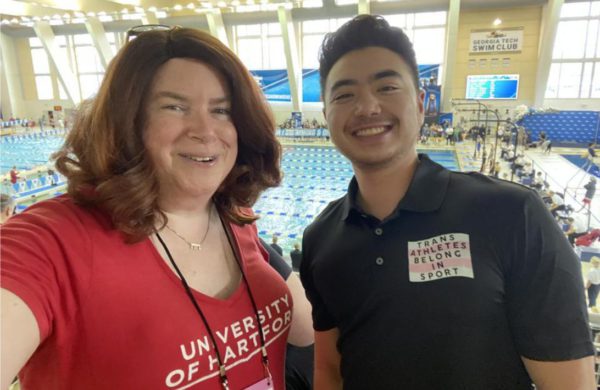
(Photo by Dawn Ennis)
Telfer’s achievement and the success of two Connecticut high school track stars sparked controversy across the country about trans girls and trans women competing with cisgender student-athletes. The Connecticut case wound up in federal court, and despite a judge tossing the suit, it’s now in the appeal phase.
The swimming success of Thomas, who up until 2019 competed with Penn’s men’s team, has been seized by conservatives as a rallying cry to generate support for bans against trans student-athletes in 11 states and for other laws that discriminate against trans American youth, such as outlawing gender-affirming healthcare, and even Florida’s Don’t Say Gay bill.
What’s missing from all that legislation is actual scientific evidence that would support the cause of groups like Save Women’s Sports. Despite dire warnings, CeCé Telfer didn’t destroy women’s sports in 2019. Laurel Hubbard didn’t destroy women’s sports at the Olympics last summer. And so far, Lia Thomas hasn’t destroyed women’s sports in 2022.
Journalist Julie Compton interviewed researcher Joanna Harper about the science for NBC News.
“The question isn’t ‘Do trans women have advantages?’ Because yes, that is so obviously true,” said Harper, a medical physicist and the author of “Sporting Gender: The History, Science, and Stories of Transgender and Intersex Athletes. Harper added that it is normal for athletes to have certain advantages and that any advantages trans women have are not necessarily unfair. “But can trans women and cis women compete against one another in meaningful competition? That’s the important question. That’s the interesting question. And that’s a question that we don’t have a 100 percent firm answer yet.”
“It’s a truism of trans athletes that we can compete in women’s sports as long as we don’t win,” said Harper, who herself is trans. “If we win, then it’s problematic. And, of course, how can you compete if you’re not allowed to win?”
The Other Trans Swimmer
Iszac Henig is the only swimmer for Yale at these championships, and is also the only man. He is a transgender man, who, in order to continue competing in women’s swimming with his Bulldogs teammates, opted to delay one part of his medical transition: He postponed the administration of the gender-affirming hormone testosterone. He did have top surgery, however.
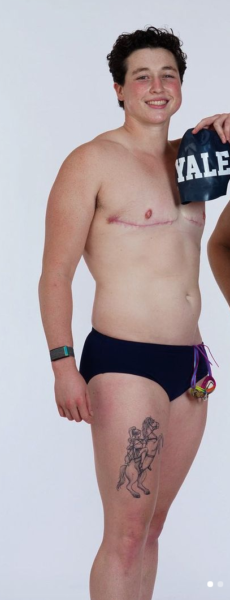
On Thursday evening, Henig finished 16th in the 50-free race, earning All-American Honorable Mention. He will compete Friday and Saturday in the the 100-butterfly and 100-free. In Saturday’s meet, he will be competing head to head against Thomas, the first time two transgender student-athletes have appeared in the same championship event.
Despite Henig being a man, Stelzer misidentified him in our interview when I asked if she was also opposed to him competing.
“If a woman who identifies as being a man wants to swim with the women, I’m all for it ,as long as they’re not taking any testosterone or other performance enhancing substances,” she said. “There might be a little bit of an issue with the mastectomy, because that could possibly streamline, so a little bit of an advantage there, some might say. But I have no issue with a woman swimming in women’s sports. And when it comes down to it, that’s a woman’s body there.”
Although Henig was not available for comment, a small but vocal group from Yale University traveled to Atlanta for the meet, and cheered him on. They told me they were beyond excited for him, and they explained that like Henig, they are not granting media interviews, but wanted it known how proud they are of him.
Dueling Protests Outside
Far from the pool, the protesters chanting “Even when we’re swimmin’ we’re standing up for women!” were separated from an equally loud group of about 20 pro-transgender inclusion demonstrators, chanting just as loud.
“Hey hey, ho, ho! Transphobes have got to go!” and “Say it loud, say it clear! Trans athletes are welcome here!” they shouted.
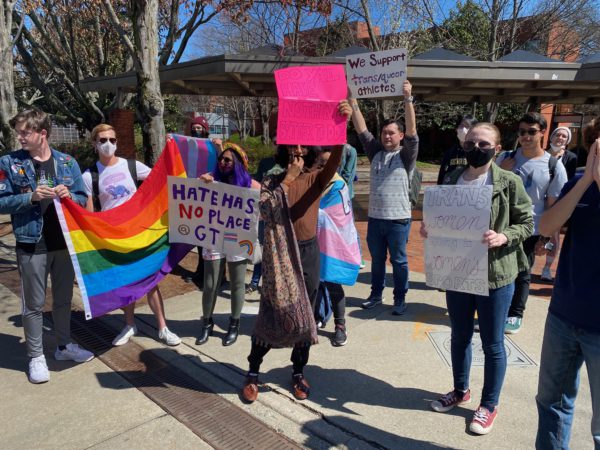
Some of those in that group were themselves trans and nonbinary. As they spoke to reporters, one of the Save Women’s Sports activists crossed the street to record the counter-protest, getting within inches of some of the demonstrators’ faces with her camera. This was when one of the officials watching the dueling protests and maintaining order stepped between her and the demonstrators, at one point directing her to back off. Her name is Kat, and she’s from New York.
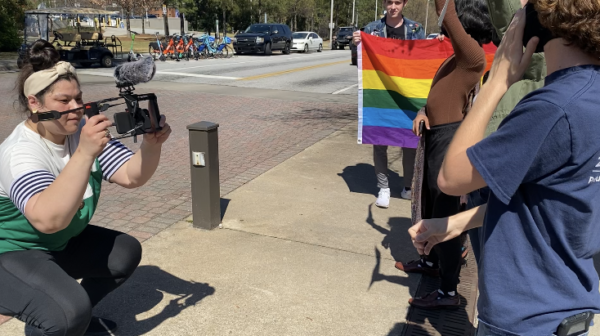
“I used to support transgender rights,” Kat told me, and later she disclosed that she used to identify as nonbinary and has trans friends and family members. “But then I learned about the government changing the laws to erase the difference between sex and gender and endangering biological women.”
Kat is referring to President Biden’s executive order, signed on the day he was inaugurated. It actually says:
“Every person should be treated with respect and dignity and should be able to live without fear, no matter who they are or whom they love. Children should be able to learn without worrying about whether they will be denied access to the restroom, the locker room, or school sports.”
It also says both Title VII and Title IX related to discrimination should include protections on the basis of gender identity. It doesn’t erase sex. It expands the scope of protections from discrimination.
Another Save Women Sports activist worked the crowd, handing out trinkets with their logo to those few spectators willing to take them. For the most part, they were later found littering the stands under seats and outside McAuley.
When the TV camera crews, reporters and photographers from the national news outlets packed up their gear and left, so did the protesters.
*************************
Editor’s Note: The preceding article was a media share between Forbes.com & the Los Angeles Blade.
Egypt
Iran, Egypt object to playing in Seattle World Cup ‘Pride Match’
Game to take place on June 26

Iran and Egypt have objected to playing in a “Pride Match” that will take place in Seattle during the 2026 World Cup.
The Egyptian Football Association on Tuesday said it told FIFA Secretary General Mattias Grafström in a letter that “it categorically rejects holding any activities related to supporting (homosexuality) during the match between the Egyptian national team and Iran, scheduled to be held in Seattle, USA, on June 26, 2026, in the third round of the group stage of the 2026 World Cup.” Football Federation Islamic Republic of Iran President Mehdi Taj told ISNA, a semi-official Iranian news agency that both his country and Egypt “protested this issue.”
The 2026 World Cup will take place in the U.S., Canada, and Mexico. The draw took place at the Kennedy Center on Dec. 5.
Iran is among the handful of countries in which consensual same-sex sexual relations remain punishable by death.
The State Department’s 2023 human rights report notes that while Egyptian law “did not explicitly criminalize consensual same-sex sexual activity, authorities regularly arrested and prosecuted LGBTQI+ persons on charges including ‘debauchery,’ prostitution, and ‘violating family values.’” Egyptian authorities “also reportedly prosecuted LGBTQI+ individuals for ‘misuse of social media.’”
“This resulted in de facto criminalization of same-sex conduct and identity,” notes the report.
The 2024 human rights report the State Department released earlier this year did not include LGBTQ-specific references.
Soccer has ‘unique power to unite people across borders, cultures, and beliefs’
The June 26 match between Iran and Egypt coincides with Seattle Pride. The Washington Post reported the Seattle FIFA World Cup 2026 Local Organizing Committee decided to hold the “Pride Match” before last week’s draw.
“As the Local Organizing Committee, SeattleFWC26’s role is to prepare our city to host the matches and manage the city experience outside of Seattle Stadium,” said SeattleFWC26 Vice President of Communications Hana Tadesse in a statement the committee sent to the Washington Blade on Wednesday. “SeattleFWC26 is moving forward as planned with our community programming outside the stadium during Pride weekend and throughout the tournament, partnering with LGBTQ+ leaders, artists, and business owners to elevate existing Pride celebrations across Washington.”
“Football has a unique power to unite people across borders, cultures, and beliefs,” added Tadeese. “The Pacific Northwest is home to one of the nation’s largest Iranian-American communities, a thriving Egyptian diaspora, and rich communities representing all nations we’re hosting in Seattle. We’re committed to ensuring all residents and visitors experience the warmth, respect, and dignity that defines our region.”
The 2034 World Cup will take place in Saudi Arabia.
Consensual same-sex sexual relations remain punishable by death in the country. The 2022 World Cup took place in neighboring Qatar, despite concerns over the country’s anti-LGBTQ rights record.
Sports
Gay speedskater racing toward a more inclusive future in sports
Conor McDermott-Mostowy says anti-DEI push is driving away corporate sponsors

LOS ANGELES — As the countdown begins to the February Winter Olympic Games in Milan, Pride House LA is shining a spotlight on queer athletes who are breaking boundaries both on and off the field. Among them is Team USA speedskater Conor McDermott-Mostowy – a fierce competitor and proud member of the queer community. With blistering speed on the ice and a steadfast commitment to equity in sports, Conor is doing so much more than winning medals – he’s redefining what it means to represent one’s country while representing one’s community.
McDermott-Mostowy is one step closer to the 2026 Winter Olympics after winning the recent silver and bronze medals at the U.S. Championships in speedskating. He appeared at a Nov. 1 event presented by Out Athlete Fund/Pride House LA in the organization’s efforts to raise funds to support Conor and other out athletes as they pursue their Olympic dreams in Milan 2026 and beyond.The Blade spoke to the star athlete to talk about resilience, representation, and the legacy he hopes to leave one day.
Blade: Huge congrats, Conor! Winning a World Cup gold is no small feat. Do you feel like this win proved something to the world – or more importantly, to yourself?
McDermott-Mostowy: Winning gold with my team last year was definitely a major goal achieved. That said, the event we won isn’t yet an Olympic event. The races that have had the most profound impact on me actually happened two years ago.
The first was the team pursuit in Obihiro, Japan. I’d always been more of an alternate for that event, since it’s typically raced by skaters who compete in both the 1500m and 5000m. But I’d been itching for the opportunity to race it at the World Cup level. I finally got that chance when a teammate had to pull out at the last minute due to a back issue. We led the race through six of eight laps, ultimately finishing third. While it was a little disappointing to fall out of the lead, I was proud to prove that I could contribute meaningfully and help the team medal.
The second race was later that year in Salt Lake City, my home ice. After competing in Japan, I came down with a lung infection that affected my performance at the next few World Cups. Fortunately, I had time to recover before the North American World Cups and World Championships. At the Salt Lake City World Cup, I was balancing competition with completing my undergraduate degree. I didn’t know what to expect, but I ended up finishing fifth in the 1000m—my highest individual finish ever—and posted a time of 1:06.91. That’s a very significant time in speedskating; only three other Americans have gone under 1:07 in that event, all of whom became world champions. That result felt like a turning point, showing me that an Olympic or World Championship medal wasn’t just a dream—it was within reach.
Blade: This PrideHouse LA event is a huge moment. What does that support from the queer community mean to you?
McDermott-Mostowy: It’s incredibly meaningful. Being queer in Olympic sport can be very isolating, both inside and outside the sport. I barely have time to socialize outside of skating, and relocating to Salt Lake City doesn’t exactly help when it comes to queer community. So having that kind of solidarity and support from the wider LGBTQ+ community really means a lot.
Blade: Do you remember the moment you realized skating could take you all the way to the Olympics?
McDermott-Mostowy: There hasn’t been one single moment. It’s been a series of them. Over the years, I’ve had many races that shattered the limits I thought I had and inspired me to reach higher. That Salt Lake City race was one of them. It made me realize I shouldn’t just aim for the Olympics. I should aim for medals.
Another key moment came in 2018 at my last Junior World Cup, when my teammate and I finished 2nd and 3rd in the mass start. That event is similar to short track but held on a long track. It was my first full year focusing on long track after previously dabbling in it, and we had no expectation of medaling. But after we did, I realized I might actually have a future in this discipline—and that I could be competitive on the world stage. It was a pivotal realization, especially as I was trying to decide whether to continue skating or pursue a traditional college experience.
Blade: What initially drew you to speedskating? How did you get into the sport—and what’s kept you motivated?
McDermott-Mostowy: I grew up on skates. I started at age two and became a strong skater early on. But I never had any interest in hockey or figure skating. One winter, I was skating with my family on the C&O Canal in Washington, D.C., when a guy skated past us on these wild-looking speed skates. I was immediately intrigued. My parents found a local club, which happened to be run by three-time Olympian Nathaniel Mills, and I was hooked.
What’s kept me going is simple: I love it. This isn’t a sport you get rich in. I’ve only earned more than $20,000 a year twice in my career, and you can’t use it to pay for college either. The motivation has to come from within—the pursuit of excellence, the dream of going to the Olympics, and pure love for the sport.
Blade: What’s been your toughest race to date, and what did it teach you?
McDermott-Mostowy: That would be the team pursuit in Japan. I wasn’t expecting to race it and had already competed in a full weekend of events before getting the call. Team pursuit is arguably the toughest event in speedskating. Stepping up without being mentally or physically prepared was a challenge, but I did it. It showed me I could push through, even under extreme circumstances.
Blade: You’ve made headlines not just for your speed, but for your openness. What was it like coming out publicly in the world of elite sport?
McDermott-Mostowy: By the time I was publicly identified as gay, I had already been out to anyone who asked. So “coming out” doesn’t feel like the right term. It wasn’t a big declaration. I had the benefit of growing up seeing openly gay athletes and being part of a supportive community. I never felt the need to hide who I was.
Eventually, as I started achieving more on the ice, people began noticing me and the content I posted, and they put two and two together. When I was asked to speak publicly about being an openly gay athlete in speedskating, I didn’t hesitate.
Blade: What have been the biggest challenges in your career – physically, mentally, or otherwise?
McDermott-Mostowy: Honestly, my entire career has been about overcoming challenges. The two biggest obstacles have been illness and finances.
I’ve dealt with asthma, a norovirus that derailed my chances in 2022, and a fatigue condition last season that affected my performance. These setbacks take a toll. Not just physically, but mentally. When you invest everything into your sport, being forced to pause or scale back is a huge emotional hurdle.
Financially, speedskating is a tough path. Even as a consistent top-20 skater in the world, I’ve only broken $20k twice in a year, and we’re paid for just nine months, even though we train year-round. I’ve leaned on friends and family for support many times just to make ends meet.
Blade: Have you ever been told – explicitly or implicitly – that being openly gay could hurt your chances with sponsors or coaches?
McDermott-Mostowy: Never with coaches. In our sport, selections are based on the clock, not someone’s opinion. My coaches have always been great.
But when it comes to sponsorships, especially over the past year, I’ve noticed a shift. As anti-DEI sentiment grows, brands are backing away from anything that could be seen as “controversial.” Being openly gay seems to fall into that category now. Since most of our income comes from sponsorships, that retreat is deeply felt.
Sports
Trans cyclist’s victory sparks outrage in conservative media
Katheryn Phillips is originally from DC
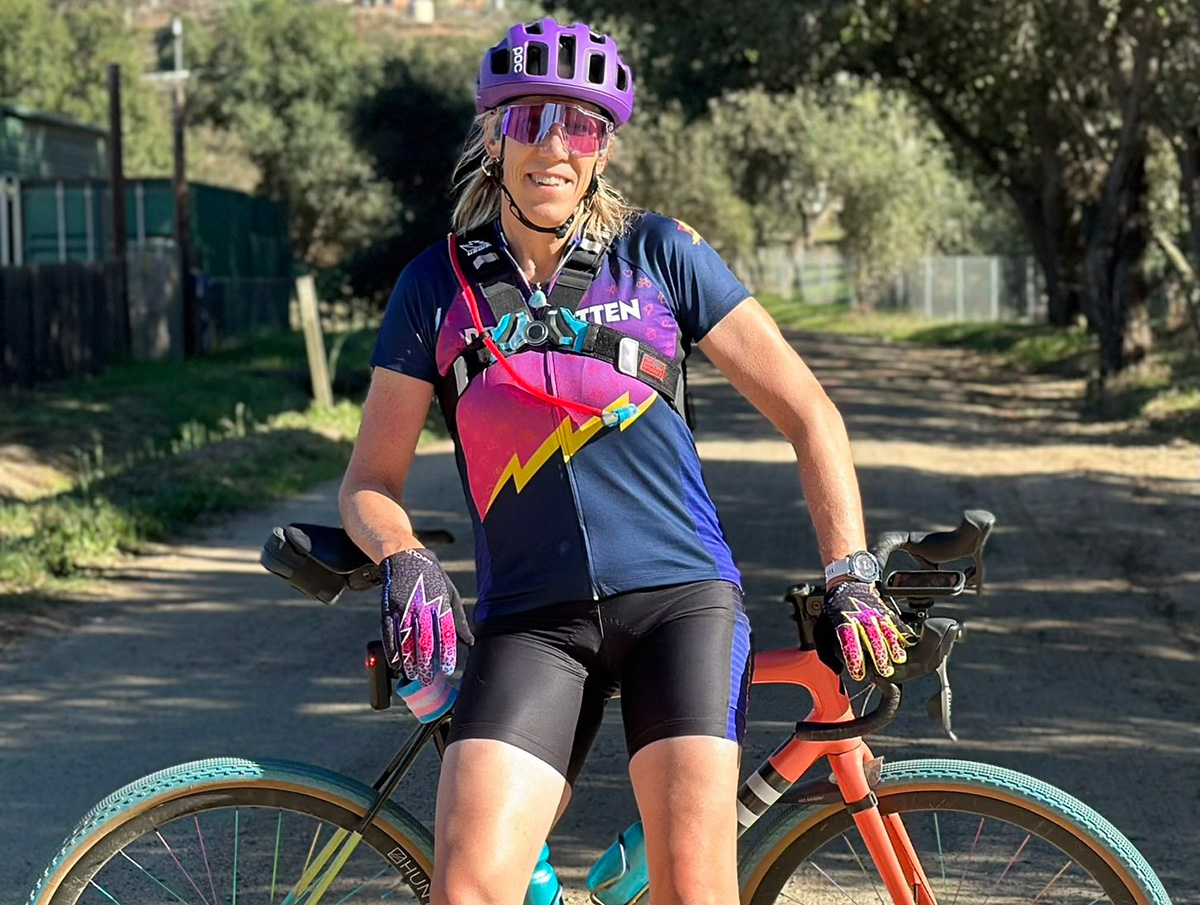
On the heels of UPenn erasing the record of the first openly transgender NCAA Division I All-American swimmer and the U.S. Supreme Court’s decision to tackle bans on trans student-athletes, right wing media is now all hot and bothered about the latest trans woman who won a cycling championship — even though she competed according to the rules.
On Tuesday, 58-year-old Katheryn Phillips finished first in USA Cycling’s Lyons Masters National Championship race for women aged 55-59, with a time of 1:42:10, according to the official results posted by the organization. The record shows her gender as “F” for female.
One second behind Phillips was Julie Peterson, with a time of 1:42:11 — as were three other cyclists: Mary Beth Grier, Andrea Cherniak-Tyson, and Carolyn Maddox.
Peterson, 57, was so outraged, she told Fox News she refused to stand on the podium in second place next to Phillips. Her story was swiftly shared by the New York Post (also owned by Fox’s parent company News Corp.), the Daily Mail, Breitbart, and other conservative media.
Both Peterson and another competitor are accusing USA Cycling of “hiding” that a transgender woman had registered to race.
“It was hidden from us. Katheryn Phillips, KJ’s name, was not on that list. And I checked it up all the way to the point of closure when we couldn’t register online anymore,” Debbie Milne told Fox.
“If I had known, I wouldn’t have spent thousands of dollars in travel and time off work to come and do a race,” Peterson said. Fox welcomed Milne, 56, who finished seventh on Tuesday, to Fox & Friends Thursday morning.
(Video courtesy of Fox News)
Peterson told Fox she did complain to USA Cycling officials prior to the race. Both Milne and Peterson referred to Phillips as a male, and with “he/him” pronouns.
“To be fair to all humans, if we want to say ‘him’ or ‘her,’ he was born a biological male, that is a fact,” Milne said. “And that is the thing that makes it an unfair advantage. Whatever has happened after that is a whole different topic.”
“I said, ‘I don’t want to race against a man,’ and they quickly scolded me and said ‘Oh, you can’t call him a man,’ and I’m like ‘Well, he is a man,’ so I was quickly scolded and corrected that it is a woman and I don’t even know what to say.”
USA Cycling did not respond to the Washington Blade’s emails requesting comment.
Phillips, who goes by Kate and by “KJ,” is a former rugby player with the D.C. Furies, who stated in the comments of a 2024 article published by Zwift Insider that she was the first out trans athlete in the U.S. to compete under the 2004 International Olympic Committee’s guidelines on trans participation.
“When USA Rugby told me about the IOC decision in 2004, I raised my hand to be included. I experience nothing but joy when I play, ride, and race,” Phillips said.
As the Blade has reported, the International Olympic Committee drastically revised those rules in 2021, and in March, Republican lawmakers in D.C. demanded the IOC ban trans female athletes from women’s sporting events altogether.
The Blade also reached out to Phillips for comment but as of press time we have not received a response. She told Zwift Insider in March 2024 she does not let those who disapprove or spread hate impact her performance or her attitude.
“I am unaffected by dissent. I love, I share joy, I am me, and I have been my authentic self for decades,” she said. It’s been reported Phillips came out in 1999, and told Zwift Insider she considers herself a lifelong cyclist.
“I’ve been on a bike for as long as I can remember,” said Phillips. “As kids, my friends and I rode all over town, we were feral kids; no cell phones, no trackers … we just roamed, and nobody got in trouble or hurt bad enough not to ride home … Scrapes/bruises/cuts were not an issue for us. In my teens, I worked for myself as a court/legal messenger, doing all of the work via my bike until I got a car. Raced BMX as a kiddo (when I mowed lawns to cover the race entry fees), I did MTB stuff (non-racing) and Sprint/Olympic Triathlons in my 30’s, and now I’m racing on Zwift, Road/Gravel, and CX in my 50s.”
In the comments section, Phillips made clear she’s not competing to win.
“I don’t do sports for victory, I do it because like many other women, I am an athlete to my core,” she said. “Unlike some, I am not there to WIN, I am there to do my best with the competitors and teammates I have around me trying to do the same…we are in it for the experience. I rejoice in their wins, and a lot of joy is reflected back to me when I have a good day.”




















